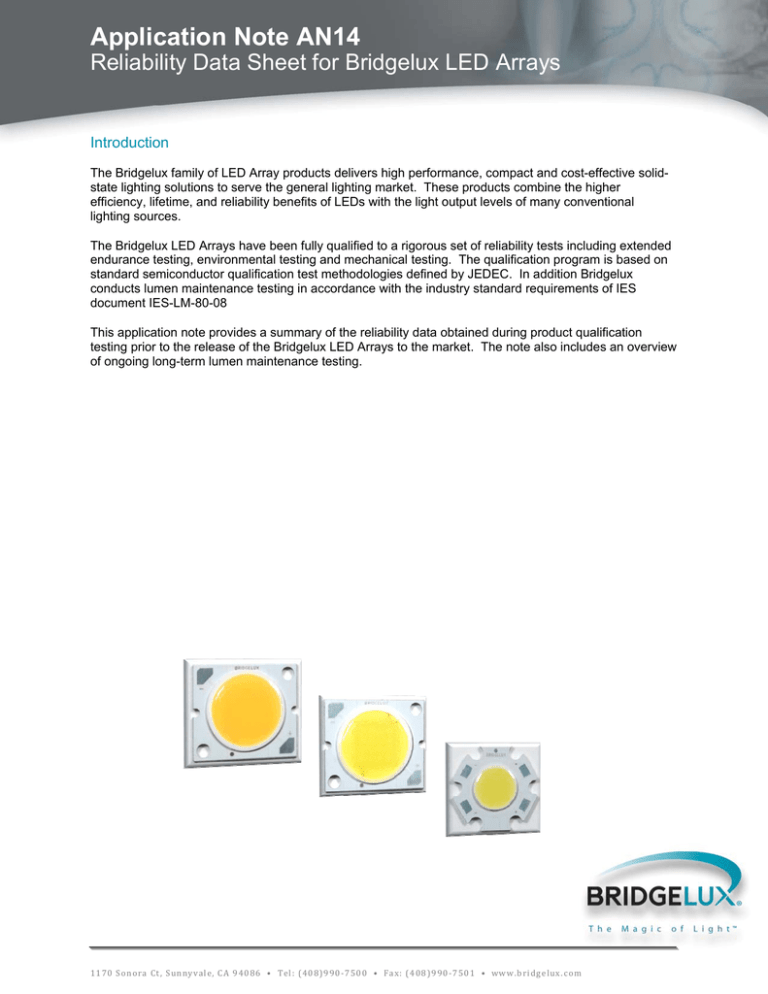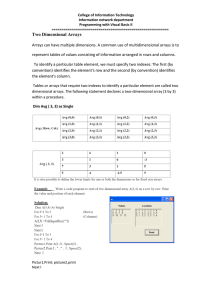
Application Note AN14
Reliability Data Sheet for Bridgelux LED Arrays
Introduction
The Bridgelux family of LED Array products delivers high performance, compact and cost-effective solidstate lighting solutions to serve the general lighting market. These products combine the higher
efficiency, lifetime, and reliability benefits of LEDs with the light output levels of many conventional
lighting sources.
The Bridgelux LED Arrays have been fully qualified to a rigorous set of reliability tests including extended
endurance testing, environmental testing and mechanical testing. The qualification program is based on
standard semiconductor qualification test methodologies defined by JEDEC. In addition Bridgelux
conducts lumen maintenance testing in accordance with the industry standard requirements of IES
document IES-LM-80-08
This application note provides a summary of the reliability data obtained during product qualification
testing prior to the release of the Bridgelux LED Arrays to the market. The note also includes an overview
of ongoing long-term lumen maintenance testing.
1 170 S ono ra Ct , S unnyv al e, CA 94 086 • Te l: (408) 990 ‐750 0 • Fa x: (408 )990 ‐750 1 • www .b ri dg elux .c om Table Of Contents
Page
Bridgelux LED Arrays – Designed For Reliability
3
Overview of LED Reliability
3
Qualification Testing Results
4
Lumen Maintenance Projections For Bridgelux LED Arrays
5
Comparing Case Temperature vs. Junction Temperature For Lumen Maintenance Projections
5
Application Note AN14: Reliability Data Sheet For Bridgelux LED Arrays (4/7/09)
Page 2 of 7
1 1 70 So no ra Ct, Su nn yva l e , CA 94 08 6 • Te l: (4 0 8) 99 0- 75 0 0 • F a x: ( 40 8) 9 90 -7 5 01 • www. b ri d ge lu x.c o m
Bridgelux LED Arrays – Designed For Reliability
Bridgelux LED Arrays are designed to ensure high reliability over a wide range of operating and
environmental conditions. The construction of the LED Arrays includes an array of high power Bridgelux
InGaN LED die bonded onto an aluminum substrate and encapsulated in a proprietary phosphor
compound.
The design of the package has been optimized to achieve maximum reliability:
•
The Bridgelux InGaN LED die used in the LED Array demonstrate exceptional stability with negligible
degradation of output power observed after more than 12,000 hours of life-test at a junction
temperature of 140˚C and operating currents in excess of 350mA per die.
•
The Bridgelux LED Arrays demonstrate industry-leading thermal resistance values ranging from
1˚C/W to as low as 0.5˚C/W. The low thermal resistance ensures that the junction temperature of the
LED die is maintained at a minimum level thereby maximizing reliability.
The low thermal resistance of the Bridgelux LED Arrays is enabled through a LED die structure in
which the thermal and electrical paths are separated. The base of the LED die is electrically isolated
and therefore allows die to be bonded directly onto an aluminum substrate using a proprietary metal
bond packaging technology, providing a thermal path of extremely low resistance.
•
Redundant wire bonds ensure high reliability in harsh environmental conditions.
•
Encapsulation and conversion materials of proven high reliability have been selected.
Overview Of LED Reliability
Bridgelux LED Arrays are inherently extremely reliable devices. The dominant degradation mechanism
for all LED products is lumen depreciation, a very gradual decrease of light output over operating lifetime.
This is characterized in the lumen maintenance statement on page 5 of this document.
LED arrays do not typically fail in a catastrophic manner in which the products fail to emit light under
normal operating conditions. Bridgelux has conducted extensive product qualification testing to ensure
that its LED Array products do not suffer from defects which may cause infant mortality. A
comprehensive set of in-process and production monitors are in place to ensure product reliability.
Accelerated degradation or catastrophic failure of a LED Array may result from inappropriate handling or
assembly procedures, the use of excessive drive currents or inadequate thermal management. Product
reliability requires conformance to the specification limits published in the data sheet and adherence to
the assembly, handling and system design recommendations published in the Application Notes.
Application Note AN14: Reliability Data Sheet For Bridgelux LED Arrays (4/7/09)
Page 3 of 7
1 1 70 So no ra Ct, Su nn yva l e , CA 94 08 6 • Te l: (4 0 8) 99 0- 75 0 0 • F a x: ( 40 8) 9 90 -7 5 01 • www. b ri d ge lu x.c o m
Qualification Testing Results
Bridgelux LED Arrays were subjected to an extensive set of qualification tests prior to product release.
The test results are summarized in the table below.
Stress Test
Reference
Specifications
High Temperature
Operating Life (HTOL)
JESD22A-108
Room Temperature
Operating Life (RTOL)
JESD22A-108
Low Temperature
Operating Life (LTOL)
JESD22A-108
Temperature Humidity
Operating Life
(WHTOL)
JESD22A-101
High Temperature
Storage Life (HTSL)
JESD22-A103
Low Temperature
Storage Life (LTSL)
JESD22-A103
Stress Conditions
85˚C case temperature
Rated IF, constant current
55˚C case temperature
Rated IF, constant current
-40˚C case temperature
Rated IF, constant current
Stress
Duration
Failure
Criteria
Results
1000 hours
Note 1,2,3,4,5
0 failures
1000 hours
Note 1,2,3,4,5
0 failures 1000 hours
Note 1,2,3,4,5
0 failures 500 hours
Note 1,2,4,6
0 failures 1000 hours
Note 1,2,3,4,5
0 failures 1000 hours
Note 1,2,3,4,5
0 failures 100 cycles
Note 1,2,3,4,5
0 failures 100 cycles
Note 1,2
0 failures Note 1,2
0 failures Note 1,2
0 failures 85˚C case temperature
85% humidity
Rated IF, constant current
120˚C ambient
Non operating
-40˚C ambient
Non operating
Case: Thigh 85˚C, Tlow -40˚C
Power Temperature
Cycle (PTMCL)
JESD22-A105C
Dwell time 16 mins
Transfer time 42 mins
Rated IF, 4 mins off, 5 mins on
Ambient: Thigh 120˚C, Tlow -40˚C
Temperature Cycling
(TMCL)
JESD22-A104
Dwell time 15 mins
Transfer time 5 mins
Non operating
Mechanical Shock (MS)
JESD22-B104-A
1500g; 0.5ms; 5 shocks/axis
Mechanical Vibration
(MV)
JESD22-B103-A
ESD I (Human Body
Model)
JESD22-114
8kV
Note 1,2
0 failures ESD II (Machine
Model)
JESD22-A115
400V
Note 1,2
0 failures Solderability
JSTD-002
260˚C ± 5˚C; 10 secs ± 1 sec
Note 1,2
0 failures Salt Atmosphere
JESD22-A107
pH = 6.0 – 7.5 at 35˚C
Note 7
0 failures 20 – 2—Hz; Random; 4 mins;
4 times/axis
5% salt solution ; 35˚C ± 3˚C
48 hours
2
Deposition rate 34g/m /24hours
Notes:
1.
2.
3.
4.
5.
6.
7.
No catastrophic failure
No parametric failure
Lumen maintenance > 70%
Change in VF < 10%
Change in white color point, ∆x, ∆y < ±0.01
Lumen maintenance > 50%
No illegible marking
Application Note AN14: Reliability Data Sheet For Bridgelux LED Arrays (4/7/09)
Page 4 of 7
1 1 70 So no ra Ct, Su nn yva l e , CA 94 08 6 • Te l: (4 0 8) 99 0- 75 0 0 • F a x: ( 40 8) 9 90 -7 5 01 • www. b ri d ge lu x.c o m
Lumen Maintenance Projections For Bridgelux LED Arrays
Bridgelux projects that it’s family of LED Array products will deliver, on average, greater than 70% lumen
maintenance after 50,000 hours of operation at the rated forward test current. This performance
assumes constant current operation with case temperature maintained at or below 70˚C.
These projections are based on a combination of package test data, semiconductor chip reliability data, a
fundamental understanding of package related degradation mechanisms, and performance observed
from products installed in the field using Bridgelux die technology. Observation of design limits is
required in order to achieve this projected lumen maintenance.
Comparing Case Temperature vs. Junction Temperature For Lumen Maintenance
Projections
The Bridgelux lumen maintenance projection is comparable with the best in the industry. Bridgelux
chooses to make lumen maintenance projections relative to a case temperature of 70˚C, as this is a
parameter that is easily measured and managed in a lighting system. Other manufacturers of LED
packages publish projections relative to the junction temperature of the die. It is not possible to measure
the junction temperature and therefore this must be calculated rather than measured. The junction
temperature of the die is always higher than the case temperature. In comparing lumen maintenance
projections, it is important to ensure that the comparison is made under the same conditions – Bridgelux
recommends comparing lumen maintenance projections relative to a case temperature.
Figure 1 compares the construction of a Bridgelux LED Array with that of a typical single chip emitter
package mounted onto a Metal Core Printed Circuit Board (MCPCB). Note that the Bridgelux LED Arrays
have a significantly simplified thermal path in comparison to a light engine built using single chip emitter
packages. As described previously, the die in the Bridgelux LED Arrays are bonded directly onto an
aluminum substrate. For the single chip emitter package, the LED die is bonded onto the emitter
package, and the package is then mounted onto a MCPCB substrate which is a required process step for
building a lighting system using LED emitters. In this example, the case temperature (Tc) of the Bridgelux
array should be compared with the temperature (Tc) at the MCPCB (substrate) for the single chip emitter.
Application Note AN14: Reliability Data Sheet For Bridgelux LED Arrays (4/7/09)
Page 5 of 7
1 1 70 So no ra Ct, Su nn yva l e , CA 94 08 6 • Te l: (4 0 8) 99 0- 75 0 0 • F a x: ( 40 8) 9 90 -7 5 01 • www. b ri d ge lu x.c o m
Tj
Tj
Tc
Tc
Typical Single Chip Emitter
Package Assembly
Bridgelux LED Array
Fig 1: Comparison of thermal path for Bridgelux LED Array and a typical single chip emitter package
The junction temperature (Tj) is dependent on the case temperature (Tc), the electrical power dissipated
(P) and the thermal resistance (RTH) of the LED package and substrate or MCPCB mounting via the
simple relationship:
Tj = Tc + (P*RTH)
For the typical single chip emitter
Tj = Tc + P*(R1 + R2 + R3+ R4 + R5)
and
R1 + R2 + R3 = thermal resistance of the emitter package
R4 + R5 = thermal resistance of the MCPCB and interface between emitter package and MCPCB
Although the MCPCB is a good conductor of heat, the incremental thermal resistance for the board and
board interface is not trivial. Typical commercially available board solutions have thermal resistance in
the range of 2˚C/W to 5˚C/W which is to be added to the thermal resistance of the emitter package to
calculate the total thermal resistance of the lighting system. It is important to evaluate the complete
system to accurately compare the performance of different LED products.
Application Note AN14: Reliability Data Sheet For Bridgelux LED Arrays (4/7/09)
Page 6 of 7
1 1 70 So no ra Ct, Su nn yva l e , CA 94 08 6 • Te l: (4 0 8) 99 0- 75 0 0 • F a x: ( 40 8) 9 90 -7 5 01 • www. b ri d ge lu x.c o m
About Bridgelux
Focused on bringing innovation to light, Bridgelux is a leading provider of high-power, cost-effective and
energy-efficient light-emitting diode (LED) solutions. The company’s proprietary epitaxy technology,
innovative chip designs and leading-edge LED packaging technology have enabled the company to
develop advanced solid-state lighting (SSL) products that offer superior quality, are lower in cost and
environmentally friendly—all without compromising performance. In addition to LED chips, the company
delivers a range of SSL light sources that customers can easily integrate into a variety of lighting
applications that will open up new markets in solid-state lighting. Founded in 2002, Bridgelux is
headquartered in Sunnyvale, California. For more information about the company, please visit
www.bridgelux.com
© 2009 Bridgelux, Inc. All rights reserved. Product specifications are subject to change without notice.
Application Note AN14: Reliability Data Sheet For Bridgelux LED Arrays (4/7/09)
Page 7 of 7
1 1 70 So no ra Ct, Su nn yva l e , CA 94 08 6 • Te l: (4 0 8) 99 0- 75 0 0 • F a x: ( 40 8) 9 90 -7 5 01 • www. b ri d ge lu x.c o m




